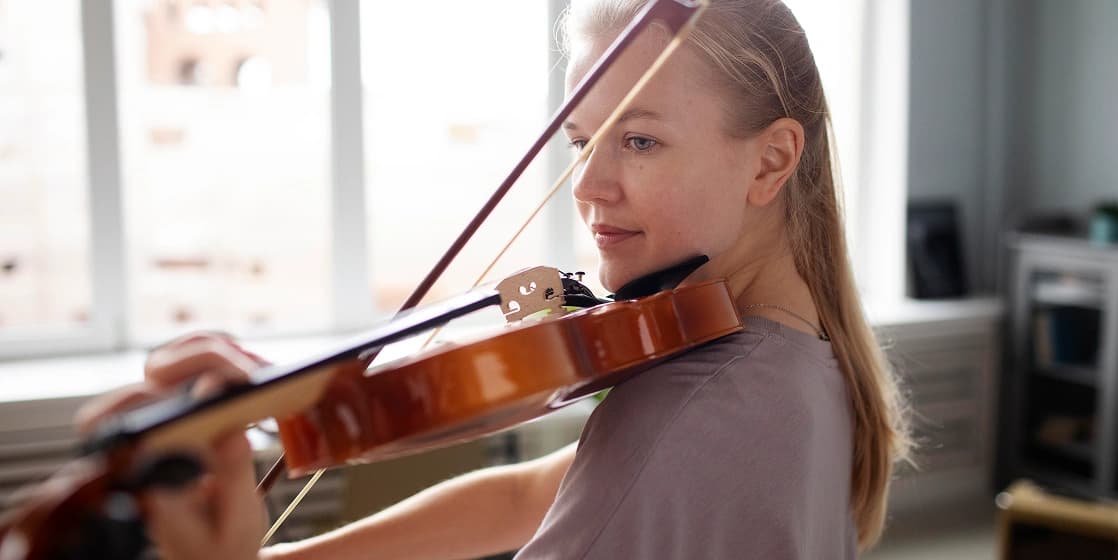Violin Intonation at Home: Drone Practice, Guide Fingers & Two-Note Targets



Violin Intonation at Home: Drone Practice, Guide Fingers & Two-Note Targets
Want to play in tune—consistently? You don’t need a fancy tuner running nonstop. With drones (a steady reference pitch), guide-finger shapes, and two-note targets, you can train your ear and hand to land notes cleanly in 10–15 minutes a day.
At B Amazing Music, our background-checked teachers coach one-on-one in your home across Winter Garden, Windermere, Lake Buena Vista, Ocoee, Clermont, and Apopka. We’ll fit your shoulder/chinrest for comfort, then map an intonation plan that clicks. Love your teacher—or we’ll make it right.
Quick answer (screenshot this)
- Drone: Practice with a quiet A-440 or open-string drone (A or D).
- Guide fingers: Keep a light “guide” finger down while placing the next one to stabilize spacing.
- Two-note targets: Perfect 5ths (ring with no beats) and clean 3rds; train small units before scales.
- Daily plan: 10–15 min → 3 min drone + 5 min guide-finger scales + 3 min two-note targets + 2–4 min phrase.
Step 1 — Drone Practice That Actually Trains Your Ear (3–5 minutes)
Setup:
- Use an open A or D drone (bow it yourself) or a drone app/sustained tone on a small speaker at low volume.
- Stand tall, bow near the bridge at pp→mp so the drone is clear and stable.
A) Open-String Pairing (1 min)
- Bow open A; on the E string, play A–B–C#–D slowly.
- Listen for beats (wavering). Fewer beats = better tune. Slide micro-adjustments until the beats disappear.
B) One-Octave Scale with “Hover Checks” (2 min)
- Play G or D major with the matching drone.
- Before placing a finger, hover above the tape/spot, pre-hear the pitch, then land and pause until it locks (beats calm). Continue.
C) 5ths & 3rds Ring (1–2 min)
- Sustain open D while placing A on the G string (perfect 5th).
- Switch to an A drone and place C# (major 3rd) and E (5th) on the E string. Aim for a “bell-like” ring.
If the sound gets fuzzy, slow the bow and move closer to the bridge. Clear tone = clearer intonation feedback.
Step 2 — Guide Fingers: The Spacing Shortcut (4–6 minutes)
Why it works: Your left hand learns consistent spacing when one finger lightly stays down and guides the next.
Basics (1 minute):
- On the D string, place 1st finger (E). While keeping 1 down lightly, drop 2 (F#). Then keep 2 down, drop 3 (G).
- Lift only as needed, but maintain a soft contact on the guide finger.
Exercise A — 1-2-3 Builder (2 minutes):
- With a D drone, play E–F#–G–F#–E slowly, keeping one finger down to guide the next.
- Repeat on A string: B–C#–D–C#–B.
Exercise B — 1-3 Frames (2 minutes):
- Place 1 and 3 together (e.g., E and G on D string), then drop 2 in between (F#).
- Roll 1–2–3–2–1 with tiny finger motion; the frame stays put.
Exercise C — Shift-Prep Slides (optional, 1 minute):
- From 1st finger E, slide a hair while listening to the drone, then return to center. Think small, slow, and relaxed.
As intonation stabilizes, fade tape reliance: keep the frame shape; trust your ear.
Step 3 — Two-Note Targets: Micro Wins That Stack (3–4 minutes)
Instead of running long scales, master tiny intervals you meet constantly.
Targets to train:
-
Half-step (1–1 or 2–2 neighbor)
- Example: F–F# on the D string.
- Keep guide finger down; roll the upper finger in/out until beats fade.
-
Whole-step (1–2, 2–3)
- Example: E–F#, F#–G.
- Land the second note from the knuckle, not the fingertip reaching.
-
Perfect 5th (string crossings)
- Example: Open D ↔ A on G, Open A ↔ E on D.
- Listen for no beats—the double-stop should ring.
-
Major/Minor 3rd (color control)
- Over an A drone, place C# (major 3rd), then C natural (minor 3rd) on the A/E strings.
- Hear the different “colors”; let the hand remember both shapes.
Pattern: Each target slow-hold → release → slow-hold (2–3 reps). Quality over quantity.
10–15 Minute Daily Plan (print/screenshot)
- Setup Check (1 min): Shoulder down, jaw soft, violin balances (hands-off for 3 seconds).
- Drone Block (3–5 min): Open-string pairing → hover-check scale → 5ths/3rds.
- Guide-Finger Block (4–6 min): 1-2-3 builder → 1-3 frame → (optional) micro-slides.
- Two-Note Targets (3–4 min): Half-steps, whole-steps, then 5ths/3rds.
- Phrase Connect (1–2 min): One tiny phrase slow, keeping the same shapes.
If time is tight: do Drone (2 min) + Guide-Finger A (2 min) + Two-Note 5ths (1 min) = 5-minute quick tune-up.
Troubleshooting (fast fixes)
- Notes “wander” after sounding right: Keep a lighter bow and shorter sustain while you lock pitches; then lengthen.
- Hand squeezes/aches: Check rest fit; thumb soft, fingers drop from the base knuckle. Shake out every 2–3 minutes.
- Drone overwhelms your sound: Lower speaker volume; bow closer to bridge with slow speed for clarity.
- String crossings go sharp/flat: Keep elbow levels steady; move the bow arm at the shoulder, not the wrist only.
FAQ
Should I watch a tuner while I play?
Use a tuner to tune strings, then switch to ear-led drones. Your goal is to hear beats disappear, not chase a needle.
Tape or no tape?
Tape can help at first, but guide-finger frames + drones build lasting accuracy. We’ll help you fade tape when ready.
How loud should the drone be?
Quiet enough that your violin leads. If you can’t hear beats, lower the drone or improve bow contact.
Does this help with orchestra auditions?
Yes—these drills tighten scales, excerpts, and sight-reading because your hand learns repeatable spacing and your ear locks to interval color.
Want hands-on intonation coaching at home?
We’ll fit your shoulder/chinrest, set up drone tracks that match your music, and design a two-week plan with guide-finger and two-note targets—in your living room.
